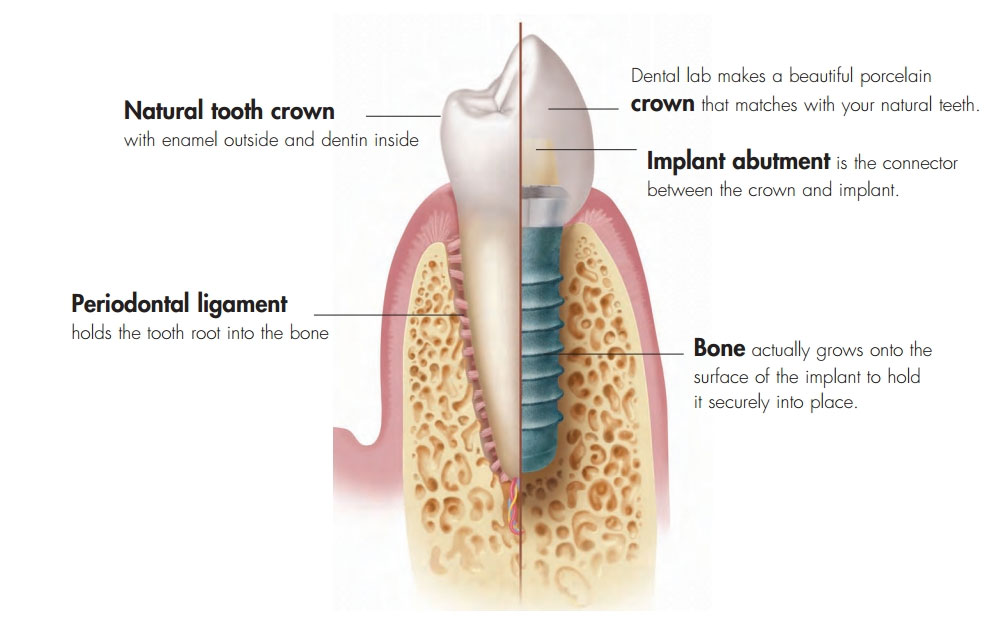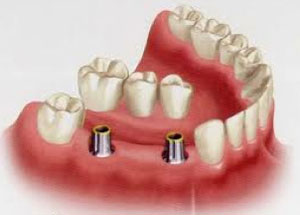There are plenty of reasons to replace missing teeth. Missing teeth may affect speaking or chewing. If a missing tooth is not replaced, the teeth around it can move. Harmful plaque and tartar can form in new hard-to-reach places. Over time, this may lead to tooth decay and periodontal (gum) diseases.
If you feel embarrassed about having missing teeth, dental implants may be an option for you. A dental implant is the closest thing to a natural tooth, and it offers comfort and stability.
What are implants?
Implants are man-made “anchors” that look like screws and replace your natural tooth roots. They are made of titanium and other materials that are compatible with the human body. They are surgically placed in the upper or lower jaw, where they become a stable base for one or more replacement teeth. Mini implants, which are smaller than regular dental implants, can be used to stabilize a removable denture. Dental implants have been used for many years. One survey by the American Dental Association shows that more than 2 million dental implants were placed in a recent year, and that number is expected to grow. Patients have chosen dental implants to replace a single tooth, several teeth or to support partial or full dentures.

It’s no surprise – there are lots of great reasons to get implants:
- Dental implants help you chew better.
- They help fill out a face that could look “sunken” because of missing teeth.
- Implants are the closest thing to natural teeth.
How are implants placed?
The way implants are placed depends on the patient, the type of implant, and the tooth being replaced. Some implants require two or three appointments and can take up to a year to complete. With others, called immediate load implants, the implant and crown can be placed on the same day. Your dentist will tell you which type is best for you.
Most implants involve two or three basic steps:
First, the dentist or surgeon surgically places the implant into the jaw. The implant attaches to the bone through a process called osseointegration that takes three to six months. Immediately after the surgery, there may be some swelling and/or pain for a few days, so your dentist may give you pain medication. Your dentist may also suggest a diet of soft foods, cold foods and warm soup while the area heals.
Next, the dentist may attach an extension, called a post or abutment, to the implant. Once healed, the implant and post can serve as the base of the new artificial tooth, or crown. Finally, the dentist makes a crown, based on a size, shape, color and fit that will blend with your other teeth. A temporary crown is placed until the permanent crown can be custom-made. Once the permanent crown is ready, it is attached to the implant or post.

Who’s a good candidate?
You are, if you’re in good health, don’t smoke, and have enough bone to support an implant. If you have experienced bone loss you may still get an implant, but first bone must be added to your jaw by a special procedure known as bone grafting. You must also be committed to good oral hygiene and visit your dentist regularly. Keep in mind that dental implants may cost more than other options. Ask your dentist if implants are right for you.
Our practices are equipped with some of the latest technology and they adhere to the highest sterilization standards. The office manager will be happy to provide you with information about our standards and technology.
While you’ll immediately be impressed by our comfortable state of the art practices, it’s usually our attentive service that patients remember the most. Our well-trained staff, along with our dentists and specialists, takes pride in making sure that your care is of the highest caliber. With us, you don’t just receive quality care during treatment, but our team also strives to give you the respect and attention you deserve throughout the duration of your visit.
